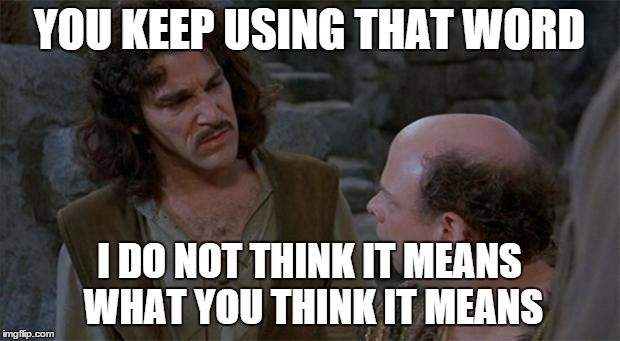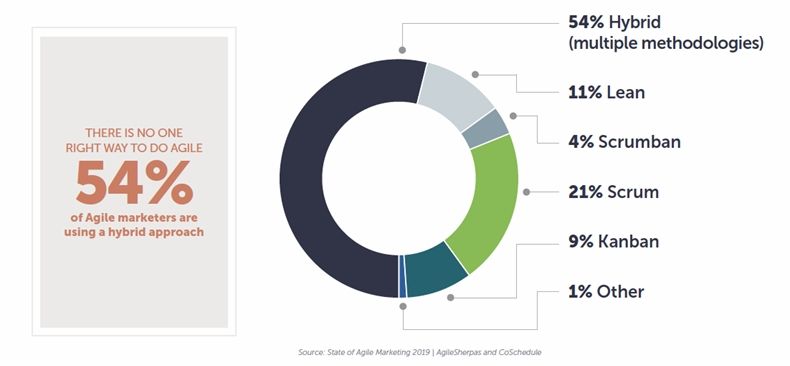More and more marketing departments are moving from being curious about Agile to actually implementing Agile practices in their day-to-day project management.
However, as Agile principles and concepts from software development get translated into the marketing context, so do a number of myths and misconceptions about Agility. Those myths often end up discouraging teams from taking up Agile practices or hindering their progress as they develop their Agile workflow.
To make sure you and your team do not end up with the wrong idea about what Agile is and what it can or cannot do, let's debunk some of the most common myths surrounding it.
Myth 1: Agile is only for startups
This myth is common, but it's easily debunked,
Agility is not just for startups or small, scrappy teams without external dependencies. Even if you're coming from a larger company with a bunch of rules already in place, you still have a fair chance of achieving Agility within your team or department.
I've seen this happen, but you don't have to take my word for it: The data is definitely there. In this year's second annual State of Agile Marketing Report from AgileSherpas and CoSchedule, you'll see that for those companies that use Agile…
- 18% have 5,000+ employees.
- 13% have 1,001-5,000 employees.
- 6% have 500-1,000 employees.
- 18% have 100-499 employees.
Those are not small companies! Less than half of Agile marketers come from startup-sized companies (employee count of under 100). Most Agile marketing teams are operating within larger enterprises with hundreds, sometimes thousands, of employees.
So don't be discouraged by naysayers who don't believe that larger, more established organizations can change for the better. The reality is different.
Chances are, applying Agile in a larger team or organization will actually produce more dramatic improvement, more quickly (if you approach it the right way).
Myth 2: Agile teams move fast and break things
Although "agile," meaning nimble, fast, adaptive, and responsive, is something to aspire to for any team, being "Agile" refers to another set of goals. Agile is a specific methodology that requires a mindset shift and proposes a set of values and principles different from those the team may have been previously used to.
In addition, in Agile, teams and leaders take on different roles and have their own sets of responsibilities regarding the way work is managed within the organization.

Next time you say "Agile," make sure it means what you intend for it to mean.
Myth 3: Agile marketing teams mostly use scrum
Selecting a method upon which to structure a team's application of Agile is almost like choosing a preferred ice cream flavor. So, saying that everyone always uses Scrum is like saying everyone's favorite ice cream flavor is always vanilla.
But according to the State of Agile Marketing report, only 21% of marketers who say they are using Agile are using Scrum in its pure form. Most Agile marketing teams (a whopping 56% of them) find it more effective to apply a hybrid of multiple methods.
By taking on practices from seemingly competing methodologies like Kanban and Scrum, marketers often end up using either Scrumban (taking on cadences, but in a more flexible way than traditional Scrum would allow) or play mix-and-match until they come up with a new hybrid that combines daily practices from both methods.

Myth 4: An Agile transformation is a one-time initiative
Hardcoded into all Agile practices, principles, and values is the belief that an Agile team can only be successful when it continually improves it internal processes.
An Agile process, like the tasks that are managed within it, should be subject to constant experimentation, review, and improvement.
That means an Agile transformation is never truly done. It's like a living thing that adapts and grows with time, at the mercy of the team.
By reflecting on how efficient and successful the process is at each iteration, we give the team opportunities to boost its quality and speed. If we allow the system to stagnate, it will become more of an obstacle, rather than a facilitator of excellent work.
Myth 5: All Agile teams look the same
This myth could not be further from the truth. In fact, you would be hard-pressed to find any two teams with the exact same practices and rituals in the ways they apply Agile on a daily basis.
When agreeing on "ways of working" that they want to adopt, team members often take into account external factors, such as dependencies, deadlines they cannot control, and other circumstances outside their purview.
Allowing marketers to be creative in crafting their own version of "best-practices" lets them be more accountable to the rules they've set (and therefore more likely to continue enforcing them).
When the team reaches a consensus about the workflow and practices they feel can help manage their process best, they have come up with a way to apply Agile that is as unique as the team itself.
Myth 6: Agile teams use a single tool
Maybe in an ideal world, sometime in the future, there will be a single tool to rule them all—the Holy Grail of Agile marketing tools.
For now, even Agile teams juggle a few tools for project management, as well as an entirely different set of tools for executing on their marketing tasks.
However, having at least one Agile project management tool in place can make all the difference. The State of Agile Marketing research finds that 32% of Agile marketing teams consider the implementation of an Agile project management tool as a top driver of success when making the switch to Agile marketing.
So keep an eye out for tools you can add to your marketing team's arsenal to help you get started with Agile marketing.
As you test various tools, keep in mind that the Agile Manifesto (where the Agile movement got its start) states that Agile teams should emphasize "individuals and interactions over processes and tools." In other words, the choice of tool can rarely make or break an Agile transformation, but problems with communication certainly can.
* * *
Now that we've debunked some myths together, it's time to talk to your team to see how many of these myths are alive and well among your team members. You may well be surprised to find that much of the "common knowledge"' surrounding Agile is not supported by data collected from real Agile marketers. So, check out this year's full report on the State of Agile Marketing.




